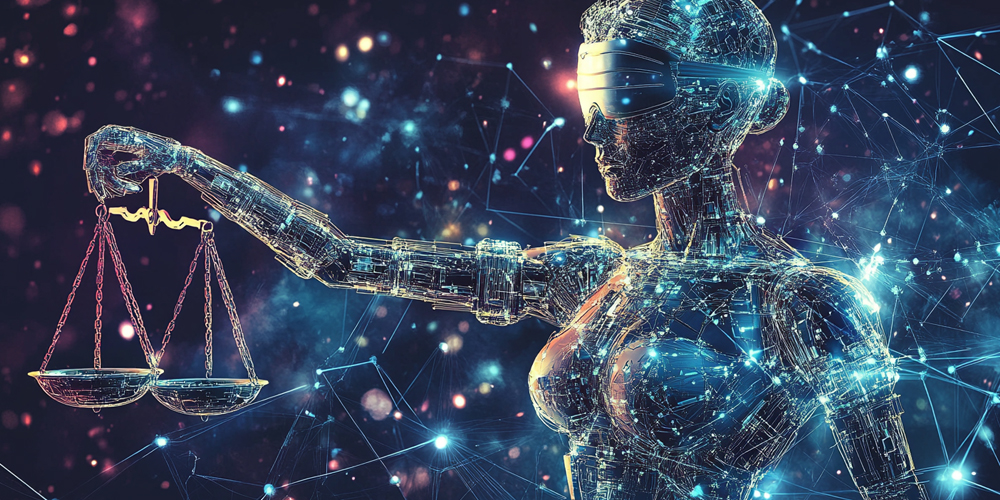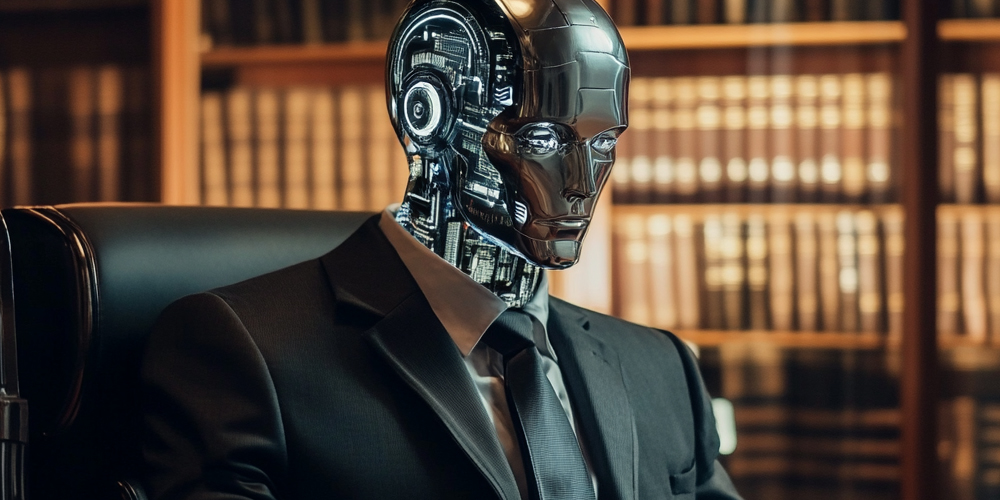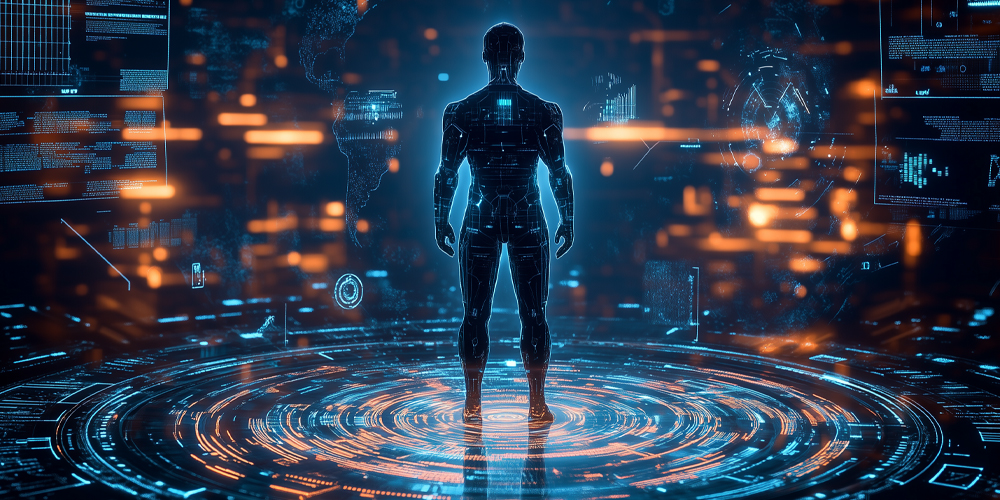Human augmentation refers to the use of technology to enhance human capabilities and improve overall quality of life. This can involve physical enhancements, such as prosthetics, or cognitive enhancements through the use of Artificial Intelligence (AI) and other advanced technologies. As we venture into the future, the integration of AI into human augmentation is expected to revolutionize how humans interact with machines and the world around them.
Artificial Intelligence in 2050: The Vision
By the year 2050, the landscape of human augmentation will be significantly shaped by Artificial Intelligence. Innovations in AI are anticipated to lead to more personalized and adaptive augmentation solutions, enabling individuals to overcome physical, cognitive, and social limitations. This will not only enhance personal capabilities but also integrate seamlessly into daily life, making advanced performance more accessible and widespread.
Examples of Potential AI-Driven Augmentation
Several examples illustrate the profound impact of AI on human augmentation by 2050:
- Augmented Reality (AR) and Virtual Reality (VR): AI-powered AR and VR systems could enhance training and education, providing immersive simulations tailored to individual learning styles. Medical professionals, for instance, could use AR to visualize patient anatomy during surgery.
- Cognitive Enhancements: AI algorithms could help manage cognitive overload by prioritizing and filtering information, enabling users to focus on essential tasks. This would be particularly beneficial for individuals with ADHD or similar conditions.
- Smart Prosthetics: By 2050, prosthetics could employ AI to learn and adapt to the user’s movements, providing a more natural and intuitive experience. For instance, an AI-integrated arm could adjust grip strength automatically based on the object being held.
- Health Monitoring Systems: AI could serve as a continuous health monitoring companion, predicting medical issues before they arise through data analysis. Wearable devices leveraging AI could send alerts for irregular health metrics, allowing for preventative care.
Ethical Implications of AI in Human Augmentation
The integration of AI in human augmentation raises several ethical questions that must be addressed:
- Accessibility and Equity: As AI advancements promote enhanced capabilities, ensuring equitable access to such technologies will be vital. Disparities in access could lead to a socio-economic divide, where only the affluent can afford advanced augmentations.
- Privacy Concerns: With AI systems monitoring physical and mental states, privacy becomes a major issue. The data collected could be exploited if not secured properly, necessitating robust regulations to protect personal information.
- Dependency on Technology: Over-reliance on augmentative technologies can impede natural abilities and critical thinking. Striking a balance between enhancement and maintaining inherent skills is crucial.
The Future of Work with AI Augmentation
The workplace will also undergo significant changes as AI facilitates human augmentation. With AI tools assisting in cognitive tasks, employees will be able to focus on more creative and strategic functions, while AI handles repetitive or data-heavy tasks. This shift will likely result in:
- Skill Redefinition: Job roles will evolve, requiring workers to adapt to complement AI technologies rather than compete with them.
- Increased Productivity: Enhanced cognitive capabilities and smart systems will streamline workflows, making organizations more efficient.
- Flexible Work Environments: AI could enable hybrid work models that cater to individual preferences and optimize performance, as augmented workers blend remote and on-site capabilities.
Conclusion and Future Directions
As we look toward Artificial Intelligence in 2050, the intersection of AI and human augmentation holds immense promise and complexity. Society must carefully navigate the challenges and ethical considerations while harnessing the potential benefits of this fusion. Continuous dialogue among technologists, ethicists, and the community will be crucial in shaping a future that enhances human potential responsibly.
Introduction to AI in Business Sustainability
As businesses increasingly recognize their environmental and social responsibilities, integrating Artificial Intelligence (AI) into sustainability practices has emerged as a transformative approach. In the context of AI in Business Sustainability, companies leverage advanced technologies to enhance operational efficiency, reduce waste, and promote sustainable practices.
Key Applications of AI in Business Sustainability
AI technologies facilitate a variety of sustainable practices across multiple sectors. Here are some examples:
1. Energy Management
Companies are utilizing AI algorithms to analyze energy consumption data, predict usage patterns, and optimize energy management. For instance, smart buildings equipped with AI systems can adjust lighting and heating based on occupancy, significantly reducing energy waste.
2. Supply Chain Optimization
AI enhances supply chain efficiency by analyzing logistics data to reduce carbon footprints. This includes optimizing delivery routes to lower transportation emissions and improving inventory management to decrease waste.
3. Predictive Maintenance
By implementing AI-driven predictive maintenance strategies, businesses can extend the life of their equipment and reduce resource waste. Sensors and machine learning algorithms can detect issues before they lead to system failures, minimizing downtime and the need for new materials.
Impact on Corporate Social Responsibility (CSR)
The integration of AI into sustainability efforts directly supports a company’s Corporate Social Responsibility (CSR) initiatives. By using AI to monitor and report on sustainability metrics, companies can demonstrate transparency and accountability, which building trust with consumers and stakeholders.
The Future: Artificial Intelligence in 2050
Looking ahead, the role of AI in business sustainability is expected to expand significantly by 2050. Here are some projected trends:
1. Advanced Analytics and Machine Learning
In 2050, it is anticipated that businesses will rely heavily on sophisticated AI analytics to drive sustainability decisions. Machine learning models will not only analyze past and present data but also simulate future scenarios, helping organizations make informed, proactive decisions.
2. Circular Economy Innovations
AI is likely to play a crucial role in promoting a circular economy, focusing on resource reusability and waste reduction. Advanced AI systems could help in the design of products that are easier to recycle and in creating more efficient recycling processes.
3. Global Collaboration and Data Sharing
The future may witness more research and development initiatives where businesses collaborate globally to share data on best practices in sustainability. AI could facilitate this by creating platforms for data exchange and joint innovation in sustainable practices.
Challenges and Considerations
While the potential of AI to drive business sustainability is immense, there are challenges to consider:
1. Ethical Implications
Companies must navigate the ethical implications of AI use, ensuring that technologies are deployed in ways that do not harm communities or exacerbate inequalities.
2. Data Privacy and Security
AI systems rely on large data sets, raising potential issues regarding data privacy and security. Ensuring that stakeholder data is protected while sharing insights will be paramount.
Conclusion
The integration of artificial intelligence within business sustainability strategies is not merely a trend but a transformative shift that is set to redefine the way companies operate. As we approach 2050, the focus will undoubtedly expand towards more innovative, efficient, and responsible practices that leverage the power of AI to create a sustainable future.
AI in Cybersecurity
The Role of Artificial Intelligence in Cybersecurity
Artificial Intelligence (AI) plays a transformative role in the realm of cybersecurity, offering advanced solutions to combat increasingly sophisticated cyber threats. By leveraging machine learning algorithms, AI systems can analyze vast amounts of data in real-time, detecting anomalies that could indicate potential security breaches. In 2050, as cyber threats continue to evolve, Artificial Intelligence in 2050 is expected to play an even more critical role in ensuring digital security.
Threat Detection and Response
One of the primary applications of AI in cybersecurity is in threat detection. Traditional security measures often rely on predefined rules, making them less effective against novel threats. In contrast, AI systems can learn from historical attack patterns and identify new threats by recognizing unusual behavior.
For example, machine learning models are able to analyze network traffic and flag any deviations from the norm, such as a user accessing sensitive information at unusual hours. This proactive stance enables organizations to respond to threats before they escalate into significant breaches.
Automated Security Operations
In the future, particularly in 2050, AI is anticipated to further automate security operations. Currently, many organizations face a shortage of skilled cybersecurity professionals. AI can help bridge this gap by taking over time-consuming processes such as log analysis and incident response.
Security Orchestration, Automation, and Response (SOAR) tools are already utilizing AI to streamline workflows, allowing human analysts to focus on high-priority tasks. By employing AI, organizations can enhance their response times and reduce the likelihood of human error, which is often exploited by cybercriminals.
Predictive Analysis
Another significant advantage of AI in cybersecurity is its predictive capabilities. By analyzing historical data and current trends, AI can forecast potential threats before they occur. This foresight enables organizations to fortify their defenses in anticipation of attacks.
For instance, AI-driven platforms can predict phishing attacks by analyzing communication patterns and identifying suspicious emails. Such predictive analysis will be essential in Artificial Intelligence in 2050, as the number of online transactions and digital interactions continue to rise.
AI-Powered Incident Response
In the event of a security breach, the speed of the response can determine the severity of the impact. AI enhances incident response through automated protocols that can isolate infected systems, contain breaches, and gather forensic data to inform further actions. This immediate response is critical in minimizing damage and recovery time.
A notable example is the use of AI in Security Information and Event Management (SIEM) systems, which aggregate data from various sources and utilize AI algorithms to efficiently identify the nature and scale of threats. AI will enhance these systems significantly by 2050, enabling them to not only respond quickly but also adapt continuously to new threats.
Challenges and Ethical Considerations
Despite the benefits, the integration of AI in cybersecurity is not without challenges. Issues such as algorithmic bias can lead to missed detections or false positives. Furthermore, the very technologies that protect against cyber threats can also be exploited by malicious actors, who may use AI to enhance their own attacks.
Ethical considerations regarding privacy and surveillance also come into play. As AI systems become more sophisticated, the risk of overreach and the potential for misuse of personal data increases. Ensuring that AI-powered tools are used responsibly will be critical in shaping the future landscape of cybersecurity.
The Future of AI in Cybersecurity: A Vision for 2050
Looking ahead to 2050, the expected advancements in Artificial Intelligence in 2050 promise a future where cyber defenses are not only automated but also intelligent enough to predict and neutralize threats autonomously. Security systems could evolve into self-sustaining networks capable of learning from global threat intelligence, adapting their defenses preemptively.
Moreover, the collaboration between human intelligence and AI could create more resilient cybersecurity postures. Cybersecurity professionals will likely shift focus from reactive measures to strategic planning, allowing for a more robust framework in tackling future threats.
AI in Education
The Evolution of Artificial Intelligence in Education
The integration of Artificial Intelligence (AI) in education has evolved significantly over the last few decades. Initially utilized for administrative tasks, AI has grown to influence various aspects of teaching and learning.
By incorporating machine learning algorithms and data analytics, educational institutions have begun to personalize learning experiences. This evolution sets the stage for a future where Artificial Intelligence in 2050 will revolutionize educational methodologies.
Enhanced Learning Experiences
One of the primary roles of AI in education is to create tailored learning experiences for students. Adaptive learning systems use AI to analyze student performance in real-time, adjusting the difficulty of tasks to suit individual learning styles. For example, platforms like DreamBox and Knewton leverage AI to suggest resources and lessons tailored to a student’s progress.
In 2050, it is envisioned that AI will facilitate immersive learning environments through Virtual Reality (VR) and Augmented Reality (AR). Students will engage with complex subjects like history and biology by stepping into virtual reconstructions of historical events or biological processes, fully supported by AI-driven interactive elements.
AI-Powered Tutoring Systems
AI-powered tutoring systems provide personalized support to students, offering explanations and additional practice in areas where learners struggle. Programs such as IBM Watson Education harness AI to give targeted feedback, helping students grasp difficult concepts.
Looking ahead to 2050, these systems are expected to evolve into fully autonomous AI tutors capable of conducting one-on-one sessions with students, adapting not only to their academic needs but also their emotional states—recognizing when a student is frustrated and switching tactics accordingly.
Streamlining Administrative Tasks
AI has also proven invaluable in alleviating administrative burdens. Tasks such as grading exams, managing schedules, and handling enrollment processes are increasingly conducted by AI systems. Software like Gradescope uses machine learning to automate grading, freeing up educators to focus on student engagement and mentoring.
By 2050, the anticipation is that Artificial Intelligence in education will streamline all administrative work, resulting in more efficient institutions, where leaders can focus on strategic initiatives rather than operational hassles.
Data-Driven Insights for Educational Improvement
AI enables institutions to analyze large volumes of data to gather insights that can inform educational strategies. By evaluating data on student performance, attendance, and engagement, AI systems can identify trends and improve curricular design.
Looking forward to 2050, educational institutions will likely employ advanced data analytics models driven by AI to forecast student success rates, optimize course offerings, and even predict dropout risks—allowing for timely intervention to ensure student retention.
Challenges and Ethical Considerations
While the future of AI in education is promising, several challenges and ethical considerations must be addressed. Issues related to data privacy, algorithmic bias, and the potential dehumanization of education are significant concerns.
In 2050, it will be crucial to develop regulatory frameworks and guidelines to ensure that the implementation of AI in education prioritizes fairness, transparency, and the well-being of students. Crafting ethical AI will be a critical task for educators, policymakers, and technologists alike.
The Role of Educators in an AI-Driven Future
The role of educators will evolve but remain essential, even in a future dominated by AI. Teachers will transition from traditional instructional roles to facilitators of learning, guiding students through personalized AI-generated pathways.
In 2050, educators will likely prioritize teaching critical thinking and creativity—skills that AI cannot replicate—preparing students to thrive in an increasingly automated world.
Conclusion
The trajectory of Artificial Intelligence in education points toward an impressive future, filled with opportunities for personalized learning, efficient administrative processes, and enhanced student support. To harness the potential of AI while mitigating its risks will require collaboration among educators, technologists, and policymakers.
The Role of Artificial Intelligence in Entertainment
As we look forward to Artificial Intelligence in 2050, the entertainment industry stands on the brink of a significant transformation. AI technologies are increasingly being integrated into various facets of entertainment, including content creation, audience engagement, and distribution processes. This section explores how AI is shaping the future of entertainment with innovative solutions and creative possibilities.
AI in Content Creation
One of the most fascinating applications of AI in entertainment is its role in content creation. AI-powered algorithms can now generate scripts, music, and even full-blown films. For example, tools like OpenAI’s GPT can draft screenplays or dialogue, while machine learning models analyze successful films to predict what elements might resonate with audiences.
In music, AI composers like AIVA (Artificial Intelligence Virtual Artist) can create original scores across various genres. By 2050, we can expect AI to play an even more central role in collaborative creative processes, blurring the lines between human artists and AI-generated content.
AI-Driven Personalization
Another significant contribution of AI to entertainment is personalized viewing experiences. Streaming services such as Netflix and Spotify already employ AI algorithms to analyze user preferences, behavior, and feedback, tailoring recommendations to individual tastes. These algorithms not only improve user satisfaction but also keep viewers and listeners engaged longer.
In 2050, we anticipate a hyper-personalized entertainment landscape where AI could curate tailored content in real-time, suggesting not just what to watch or listen to next but also creating completely unique experiences based on individual mood or context.
Enhanced Audience Engagement
The use of AI extends beyond just content recommendations; it also enhances audience engagement through interactive mediums. Virtual reality (VR) and augmented reality (AR) experiences, powered by AI, could allow users to immerse themselves in different narratives actively.
Imagine a future where audiences can influence the storyline or characters of a movie in real-time, creating unique and individualized stories. This interactive approach, potentially available by 2050, could transform passive viewers into active participants in storytelling.
Challenges and Ethical Considerations
Despite the exciting prospects of AI in entertainment, there are challenges and ethical considerations to address. The risks of deepfakes and manipulated media could undermine trust in content authenticity. Furthermore, there is an ongoing discussion about the replacement of human jobs in creative fields due to automation.
As highlighted in discussions on the challenges and opportunities of AI in the digital age, it is crucial for stakeholders in the entertainment industry to navigate these challenges thoughtfully. Striking a balance between leveraging AI’s capabilities and preserving human creativity will be essential to ensure ethical practices and positive outcomes.
Future Opportunities in AI-Enhanced Entertainment
Looking ahead to 2050, the potential for AI to revolutionize entertainment is immense. From fully automated film production units to AI-driven virtual actors, the boundaries of traditional entertainment will continue to expand. Furthermore, advancements in self-learning AI could result in systems that not only create content but also adapt and evolve alongside audience preferences.
This progressive evolution is evident in ongoing research into self-learning AI technologies that could push the envelope of innovation. The convergence of AI with other cutting-edge technologies promises to unlock new frontiers in storytelling, engagement, and participatory experiences.
Conclusion: The Future of AI in Entertainment
The entertainment landscape is poised for transformation as we approach 2050, driven by Artificial Intelligence. While challenges exist, the potential for creativity, personalization, and dynamic engagement offers tantalizing possibilities for the future. As we continue to explore these advancements, the need for thoughtful integration of technology in entertainment grows ever more significant.
Overview of Artificial Intelligence in Healthcare
The field of Artificial Intelligence in Healthcare has witnessed transformative advancements, integrating cutting-edge technologies to enhance patient care, streamline operations, and improve medical outcomes. By 2050, the landscape of healthcare is expected to undergo a radical shift, characterized by the pervasive use of AI in various aspects of medical practice.
Key Applications of AI in Healthcare
Diagnostic Assistance
One of the most promising applications of AI lies in diagnostic assistance. Machine learning algorithms can analyze medical images with precision that often surpasses human radiologists. For instance, AI software like Google’s DeepMind has shown remarkable accuracy in detecting eye diseases, potentially enabling early intervention and preventing vision loss. By 2050, it is anticipated that AI systems will routinely assist healthcare providers in diagnosing a wide range of conditions, from cancers to cardiovascular diseases, enhancing the speed and accuracy of medical diagnoses.
Personalized Medicine
AI is also paving the way for personalized medicine, where treatments are tailored to individual patient profiles. By leveraging big data, AI can analyze genetic information, lifestyle choices, and environmental factors to suggest the most effective treatment plans. By 2050, we can expect AI-driven platforms to provide real-time personalized treatment recommendations, improving patient outcomes while reducing adverse effects from overly generalized treatment protocols.
Operational Efficiency
Healthcare facilities are increasingly adopting AI to enhance operational efficiency. From optimizing staff scheduling to managing supply chains, AI algorithms can analyze patterns and predict future demands. For example, AI systems can monitor patient flow in hospitals to reduce wait times and improve resource allocation. By 2050, AI is expected to play a crucial role in the overall management of healthcare facilities, leading to more streamlined operations and reduced costs.
AI in Drug Discovery
The drug discovery process has been notoriously lengthy and expensive. However, with the advent of AI, researchers can analyze vast datasets to identify potential drug candidates more quickly and accurately. For instance, in recent years, AI has been used to predict how different compounds interact with biological targets, significantly speeding up the initial phases of drug development. By 2050, it is expected that AI will dominate the entire drug discovery process, allowing for the rapid development of new medications based on real-time data analysis and modeling.
Challenges and Ethical Considerations
Despite the promising advancements, the integration of Artificial Intelligence in Healthcare raises several ethical and practical challenges. Issues such as data privacy, algorithmic bias, and the transparency of AI decision-making must be addressed. For instance, AI systems trained on biased datasets may lead to unequal healthcare outcomes across different demographics. Moving towards 2050, it is crucial to develop robust frameworks that ensure ethical AI use while maintaining high standards of patient care and safety.
The Future of AI in Healthcare by 2050
As we look toward 2050, the role of AI in healthcare will likely expand exponentially. Innovations such as AI-powered telehealth solutions, predictive analytics for preventive care, and smart wearable devices will become commonplace, allowing for continuous health monitoring and management. Emphasizing collaboration between AI technologies and healthcare professionals will pave the way for a more intuitive and efficient healthcare system, ultimately aiming to improve patient outcomes and reduce healthcare costs.
Understanding AI in Service Innovation
Artificial Intelligence (AI) is dramatically transforming the landscape of service innovation across various industries. By automating processes, enhancing customer experiences, and enabling data-driven decision-making, AI is reshaping how services are designed, delivered, and consumed.
Redefining Customer Experience
At the core of AI in service innovation is the ability to provide personalized customer experiences. AI algorithms analyze vast amounts of data to understand consumer preferences and behavior. For instance, chatbots powered by AI can offer 24/7 customer support, resolving queries in real-time and efficiently handling multiple requests simultaneously.
In the travel industry, companies like Booking.com utilize AI to recommend personalized travel itineraries based on past bookings and user preferences. By 2050, we can expect advancements in AI to create hyper-personalized experiences that not only predict what consumers want but also proactively offer them services before they even request them.
Operational Efficiency and Cost Reduction
AI technologies streamline operations by automating routine tasks, allowing businesses to allocate resources more strategically. In sectors such as healthcare, AI can assist in administrative tasks like scheduling appointments and managing patient records, thereby reducing overhead costs.
A prime example can be seen in the fast-food industry, where companies like McDonald’s employ AI-powered kiosks for taking orders. This not only speeds up service but also minimizes human error. By 2050, the prevalence of AI in automating supply chain logistics is anticipated to ensure smoother operations and lower costs across various industries.
Data-Driven Decision Making
AI empowers organizations with actionable insights derived from large sets of data. Predictive analytics allows businesses to forecast trends, understand consumer behavior, and make informed strategic decisions.
Retail giants such as Walmart leverage AI to optimize inventory management and pricing strategies by analyzing shopping patterns and predicting product demands. As we look toward 2050, AI’s potential to enhance decision-making processes will likely lead to smarter business models that continuously adapt to market changes.
Innovation through New Service Models
AI is not just improving existing services but also paving the way for new service models entirely. The rise of subscription services, on-demand platforms, and smart devices are largely attributed to advancements in AI technology.
Take the example of ride-hailing services such as Uber and Lyft, which utilize AI algorithms for route optimization and dynamic pricing. In the future, the integration of AI with emerging technologies, such as the Internet of Things (IoT), will likely result in innovative service models we cannot yet envision.
Ethical Considerations in AI Adoption
As the reliance on AI in service innovation grows, so do the ethical considerations surrounding it. Issues of data privacy, bias in algorithms, and the implications of job displacement must be critically addressed.
By 2050, it will be essential for organizations to establish ethical frameworks and regulations governing AI applications to ensure the technology is used responsibly and equitably. Therefore, a balance between innovation and ethical responsibility will be crucial for sustainable growth in service industries.
The Future Outlook
The trajectory of Artificial Intelligence in 2050 suggests a world where AI is deeply integrated into every aspect of service innovation. Businesses that embrace AI will have the opportunity to enhance operational efficiencies, revolutionize customer experiences, and adapt to rapidly changing market conditions.
As we move towards 2050, the potential of AI to innovate services will not just elevate organizational performance but will also redefine the very nature of service delivery. With continuous advancements in technology, the possibilities are limitless, paving the path for a service-based economy driven by Artificial Intelligence.
Transformative Role of Artificial Intelligence in Transportation
Artificial Intelligence (AI) is poised to reshape the transportation and mobility landscape significantly by the year 2050. As urbanization accelerates and populations burgeon, traditional transportation systems face immense pressure to adapt. AI technologies are being integrated into various components of transportation, enhancing efficiency, safety, and accessibility.
Autonomous Vehicles: The Future of Personal Mobility
By 2050, self-driving cars and autonomous public transportation systems are expected to be commonplace. Using advanced AI algorithms, these vehicles can process vast amounts of data from sensors, cameras, and external signals to navigate complex environments. For instance, companies like Waymo and Tesla are already testing fully autonomous vehicles that can operate without human intervention. This shift could lead to a dramatic reduction in traffic accidents, which statistics show are largely due to human error.
Smart Traffic Management Systems
AI’s integration into traffic management systems will transform how cities manage vehicle flow. By 2050, cities may employ AI algorithms to predict traffic patterns and optimize traffic signals in real time. For example, AI can analyze data from cameras and sensors to adjust signal timings dynamically, reducing congestion and improving travel times. Such systems also pave the way for vehicle-to-infrastructure communication, allowing vehicles to share information with traffic lights and road signs for a more coordinated flow.
Public Transport Revolution
The public transportation sector is set to undergo a significant transformation through the adoption of AI by 2050. AI-driven models can predict passenger demand, enabling transit authorities to adapt services dynamically. For example, New York City’s MTA has begun integrating AI to optimize bus routes based on real-time data. Further, AI chatbots will enhance user experiences by providing instant assistance for route planning and fare queries.
Impact on Mobility as a Service (MaaS)
Mobility as a Service (MaaS) is a concept gaining traction with the proliferation of AI technologies. By 2050, users will be able to access integrated multimodal transport options through a single platform— employing a combination of buses, bikes, ride-sharing, and autonomous vehicles. AI will facilitate seamless transitions between different modes of transport by providing real-time updates and suggestions tailored to users’ preferences.
Environmental Considerations and AI
One of the crucial benefits of Artificial Intelligence in Transportation is its potential to enhance environmental sustainability. AI algorithms can optimize routing for freight and personal vehicles, minimizing fuel consumption and emissions. As cities aim for net-zero carbon targets by 2050, AI’s role in energy-efficient driving patterns and fleet management will be pivotal. For instance, logistics companies such as Amazon are already employing AI to plan delivery routes that reduce energy use and emissions.
Challenges and Ethical Implications
Despite the numerous benefits, the integration of AI in transportation poses challenges that must be addressed. By 2050, ethical considerations regarding data privacy, algorithmic bias, and job displacement due to automation will need careful navigation. Policymakers must implement frameworks that protect user privacy while ensuring equitable access to AI-driven transportation solutions.
Conclusion: The Road Ahead
The trajectory of Artificial Intelligence in Transportation and Mobility paints a picture of convenience and efficiency, but it also requires thoughtful planning and stakeholder collaboration. By 2050, urban mobility will likely exist in a state of continual evolution, significantly influenced by AI developments, paving the way for smarter, safer, and more sustainable transportation solutions.
Understanding Artificial Intelligence’s Role in Employment
Artificial Intelligence (AI) is increasingly becoming an integral part of various industries, reshaping how businesses operate and impacting employment opportunities. By 2050, the landscape of work will be drastically different due to advancements in AI technologies. These developments can lead to both job displacement and the creation of new roles, posing a complex challenge for the global workforce.
Job Displacement Due to Automation
One significant area where Artificial Intelligence in 2050 will have an impact is through automation. AI systems are capable of performing repetitive tasks with greater efficiency and consistency than humans. Industries such as manufacturing, transportation, and retail are already experiencing automation. For example:
- Manufacturing: Robots equipped with AI are handling assembly lines, precision tasks, and quality control, reducing the need for human labor.
- Transportation: Autonomous vehicles may replace truck drivers, impacting millions of driving jobs globally.
- Retail: Automated checkout systems and AI-driven inventory management are changing retail dynamics, minimizing the need for cashiers.
This shift can lead to significant job losses in certain sectors, particularly for roles that involve repetitive tasks. By 2050, estimates suggest that as many as 800 million jobs could be displaced by automation globally, leading to economic and social challenges.
Creation of New Job Opportunities
While AI poses risks of job loss, it also presents numerous opportunities for new job creation. The rise of Artificial Intelligence in 2050 will necessitate a workforce skilled in managing, developing, and maintaining AI systems. Some areas of job growth include:
- Data Analysts: As organizations increasingly rely on data, the demand for professionals who can analyze and interpret this information will rise.
- AI and Machine Learning Engineers: The growth in AI technologies will require specialists to build and improve these systems.
- AI Ethics Consultants: With ethical concerns surrounding AI, new roles focused on addressing these challenges will become essential.
By focusing on re-skilling and up-skilling the workforce, society can pivot to meet the new demands of a technology-driven market.
The Importance of Education and Training
As AI transforms industries, education and training become critical in ensuring that workers remain relevant in the job market. Businesses, governments, and educational institutions will need to collaborate to develop training programs that equip individuals with necessary technological skills. Upskilling the current workforce and providing opportunities for life-long learning will be essential. Education systems must evolve to include:
- Technological Literacy: Integrating AI-related courses from an early age to foster an understanding of technology.
- Soft Skills: Emphasizing creativity, emotional intelligence, and critical thinking, which are less likely to be replicated by machines.
- Professional Development: Offering ongoing training for existing employees to adapt to new technologies.
Conclusion on AI’s Future Impact on Employment
The impact of Artificial Intelligence in 2050 on employment will be profound. While the fear of job loss due to automation may be prevalent, the potential for new job creation and the need for a skilled workforce may provide opportunities that have yet to be fully realized. Preparing for this transition through education and training initiatives is crucial to harnessing the full potential of AI while mitigating its challenges.
Ethical and Regulatory Considerations
Introduction to Ethical Implications
The rapid advancement of Artificial Intelligence in 2050 poses significant ethical challenges that society must address. As AI systems become more autonomous and pervasive, the ethical implications of their decision-making processes, data collection practices, and overall impact on human behavior will require thorough examination and robust regulatory frameworks.
Autonomy and Accountability
One major ethical consideration is the autonomy of AI systems. In 2050, AI may surpass human performance in various fields, leading to a potential erosion of personal responsibility. For example, if an AI system makes a critical decision in healthcare—or even in legal systems—who is accountable if that decision results in harm? This raises the need for clear guidelines on accountability and the establishment of legal frameworks that define the responsibilities of developers, users, and AI itself.
Bias and Fairness
Another pressing ethical concern is bias. AI systems learn from historical data, which may reflect societal prejudices. As a result, if left unchecked, Artificial Intelligence in 2050 could perpetuate and amplify these biases in critical areas such as hiring, law enforcement, and lending practices. For instance, if an AI algorithm used for hiring tends to prioritize candidates from certain demographics, it could exclude qualified individuals from underrepresented groups. Ensuring fairness in AI requires continuous monitoring, diverse datasets, and the implementation of bias mitigation strategies.
Privacy and Data Protection
With advancements in AI, particularly through the proliferation of big data, privacy will be a major issue. In 2050, AI systems could collect and analyze unprecedented amounts of personal data. This raises substantial concerns about informed consent and the protection of individual privacy. Regulations such as the General Data Protection Regulation (GDPR) provide a foundation for privacy protection; however, as AI technology evolves, there may be a need for more tailored regulatory measures to ensure that data collection and processing are ethical and transparent.
Job Displacement and Economic Impact
The impact of AI on the job market is another critical area for ethical consideration. As machine learning continues to automate tasks traditionally performed by humans, significant job displacement is expected. In 2050, entire industries could be transformed, leading to economic challenges such as unemployment and inequality. Policymakers must consider ethical and equitable ways to support transitioning workers through retraining programs and social safety nets to mitigate these effects.
Regulatory Frameworks: Current Trends and Future Directions
Regulating AI is complex due to its rapid development and the diversity of its applications. As of 2023, several countries are beginning to establish regulatory frameworks aimed at managing AI’s ethical implications. For example, the European Union has proposed the AI Act to create a comprehensive legal framework categorizing AI systems based on risk levels and establishing guidelines for transparency, accountability, and safety.
International Cooperation
Given the global nature of technology, international cooperation will be essential for addressing ethical and regulatory challenges associated with AI. Common standards and collaborative frameworks can ensure that AI development aligns with shared values, fosters innovation, and protects fundamental human rights. In 2050, nations must work together to establish ethical guidelines that transcend borders, as the implications of AI technology do not respect geographical boundaries.
Conclusion: The Need for Proactive Measures
As society moves towards a future dominated by Artificial Intelligence in 2050, there is an urgent need for proactive measures in both ethical considerations and regulatory frameworks. By prioritizing accountability, fairness, privacy, and international cooperation, we can shape AI development in a way that upholds ethical standards while fostering innovation and societal benefit.







